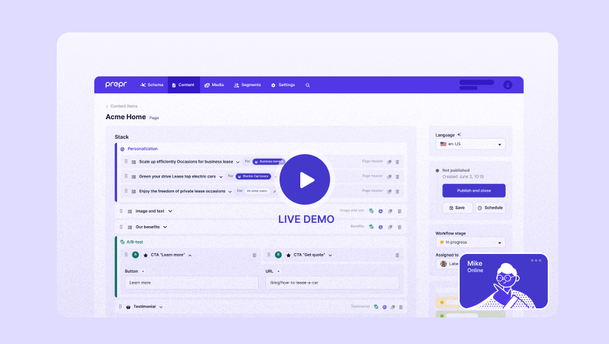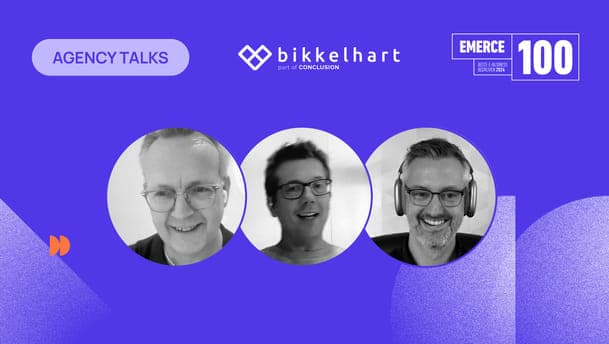To compete in the digital-first era, marketing teams need to achieve rapid digital transformation. This means that you need more out of a content management system (CMS) to deliver in the now and the future. That’s why selecting the right CMS for digital agencies becomes imperative.
What are my options for CMS for digital agencies?
In this blog, we will unpack the different types of CMSs and discuss what they can offer to help you select the best type for your agency.
1. CMS for agencies - The traditional CMS
In these CMS platforms, the user selects a frontend template for a platform to make it easy to create, change, and publish content for a location using a WYSIWYG or HTML editor. This is super helpful when you're looking for a cms for marketing agencies because it makes managing content for specific marketing needs a lot easier.
A traditional CMS organizes content in webpage-oriented frameworks commingled with code enabling it to be used on the linked frontend.
2. CMS for agencies - The headless CMS
A headless CMS is an API-first content platform that focuses on the back-end and disconnects it from any specific front-end. Instead, raw content is delivered to your channel of choice such as an app, using Application Programming Interfaces.
How to choose a CMS for your agency?
The type of content you need to create and the type of frontend you need to manage should determine the type of CMS you require. Let’s unpack each option’s offerings, benefits and cons so you can see which one will suit your needs best.
When is a traditional CMS for agencies a better fit?
Traditional CMSs are easy to set up, use, and work for basic websites such as blogs, personal sites, generic themes, and smaller company websites. They are made for publishing content to one channel.
If your agency has a smaller team with limited bandwidth or experience to implement and use a headless CMS, then the traditional CMS solution would be a cheaper and easier option.
Pros and cons of a traditional CMS for agencies:
- Offers downloadable templates and extensions to customize the website.
- Allows users direct access and previews while editing the data.
- You can install custom plugins to allow more functionality.
If you are a smaller agency that caters to only a few clients or are very niche in what you do, then stick with a traditional CMS.
When is a headless CMS for agencies a better fit?
If you need to develop websites, mobile apps, digital displays, and conversational interfaces you need the increased flexibility and scalability provided by headless CMS software solutions. Choosing a headless CMS for agencies is like having a super flexible tool that not only gives you the freedom for various digital platforms but also grows with your projects' needs.
Selecting an agency-ready headless CMS will enable you to deliver exceptional digital experiences for your clients through stunningly immersive advertising campaigns.
Pros of a headless CMS for agencies:
- Increases efficiency, and faster development.
- Content teams enjoy freedom from ongoing technical involvement.
- Delivers native content across all platforms, applications, and devices with API-native integrations.
- Acts as a built-in repository.
- Enables the combination of content analytical data from your headless CMS with your customer data
- Supports increased complexity and sophistication, integrates with new technology, meets security and legal requirements, and accelerates your speed to market.
- Allows your development team to work with their preferred technologies and frameworks via a singular GraphQL endpoint.
- Reduces any security risks as your data is completely separated from the frontend website.
The cons of a headless CMS for agencies:
- might make some scenarios more complicated, such as testing new features without affecting live environments.
- data is housed in the cloud which could complicate access to it when you stop paying your subscription fees.
Conclusion
There are many CMS options available, and the type of content and digital presence you require will determine the type that suits you best. With numerous CMS options available, it's essential to align your choice with the specific needs of your content and online requirements. When it comes to finding the best CMS for agencies, it's crucial to consider factors such as analytics, A/B testing tools, and personalization features, so you can localize content and deliver SEO-optimized content globally. Not all traditional and headless CMSs are created equal, so selecting the best CMS for agencies becomes a vital criterion in maximizing your digital capabilities.
Do you want to learn more about how the next generation of CMS for digital agencies can help your organization deliver better digital customer experiences? Have a look at our guides for valuable insights. At Prepr we pride ourselves on our specialized partnerships with agencies. Contact us to discuss your project and find out what benefits you can get as an agency.







